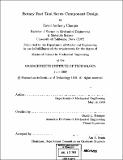Rotary fast tool servo component design
Author(s)
Chargin, David Anthony, 1974-
DownloadFull printable version (11.70Mb)
Advisor
David L. Trumper.
Terms of use
Metadata
Show full item recordAbstract
This thesis covers the design and implementation of the components of a novel rotary fast tool servo (RFTS). The RFTS enables diamond turning of rotationally asymmetric optics, with an emphasis on eyeglass lenses. These components include the rotary arm which supports the cutting tool, a high resolution angular sensor for position feedback, and a labyrinth seal system to protect the rotary axis hearings. The design of the tool arm meets several conflicting challenges, including maintaining low rotational inertia and high stiffness while providing an integrated tool height adjustment mechanism. A new, novel "double-diaphragm" actuator is developed, which provides sub-micrometer level tool height adjustment. This actuator enables the tool arm to he constructed with little additional material, meeting the low inertia goals without compromising stiffness. The high resolution angular feedback hack sensor selected for the machine is a diffractive laser design. It was successfully interfaced into the machine, both mechanically and electrically, to provide ~ 10 nanometer resolution in cutting tool location. This was essential in enabling the RFTS to turn lenses with micrometer accuracy. Finally, a new possibility of developing rotational damping with a labyrinth hearing seal is explored. Rotational damping is created by exploiting the shear forces developed between a viscous fluid and a labyrinth with a fine gap size. This provides excellent sealing as well as rotational damping.
Description
Thesis (S.M.)--Massachusetts Institute of Technology, Dept. of Mechanical Engineering, 1999. Includes bibliographical references (p. 185-188).
Date issued
1999Department
Massachusetts Institute of Technology. Department of Mechanical EngineeringPublisher
Massachusetts Institute of Technology
Keywords
Mechanical Engineering